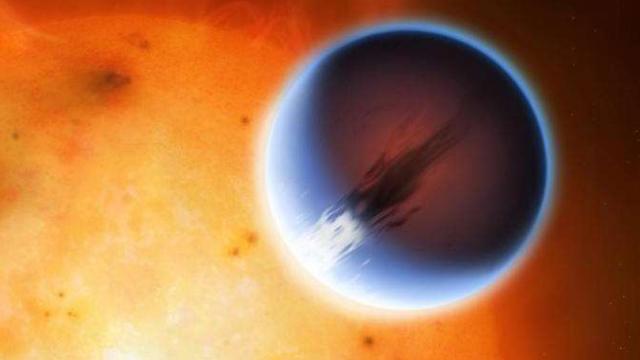Astronomers have measured and mapped a weather system on a planet outside our solar system for the first time, and interstellar camping trips maaaay not be so much fun after all. On planet HD 189733b, at least, the winds are blowing at a robust 8690km/h.
A team of astronomers at the University of Warwick measured air currents on either side of HD 189733b as it moved in front of its star. From the gas giant’s dayside to its nightside, the winds are gusting roughly seven times the speed of sound. That’s twenty times faster than the highest wind speeds ever recorded on Earth.
How do you even begin to measure the wind on a planet that’s little more than a faint shadow crossing in front of a distant star? By taking advantage of the Doppler effect.
Remember that one from high school physics? It’s the reason an ambulance’s siren becomes higher pitched as it speeds toward you: The frequency (and in the case of sound, pitch) of a wave as perceived by an observer changes depending on the relative velocity of the object producing that wave.
Only in this case, we’re talking about lightwaves instead of sound, and the moving object in question is the planet itself.

Planet HD 189733b crossing in front of its star. The changing illumination of the planet’s atmosphere allowed astronomers to measure wind speeds. Image Credit: Louden and Wheatley 2015.
As HD 189733b’s two hemispheres alternately swung towards and away from the Earth, astronomers measured subtle shifts in the wavelengths of light scattering off its atmosphere. Specifically, the atmosphere appeared blue-shifted as it rotated toward our telescopes; red-shifted as it spun away. After correcting for the rotation of the planet itself, the astronomers used this Doppler shift to calculate windspeed and direction.
“As parts of HD 189733b’s atmosphere move towards or away from the Earth the Doppler effect changes the wavelength of this feature, which allows the velocity to be measured,” lead researcher Tom Louden said in a statement.
HD 189733b is a giant, hot blob of gas — not exactly a great vacation prospect. But in the future, Louden’s technique might be used to study the atmospheres of small, rocky planets, and to figure out how “Earth-like” they actually are.
“We are tremendously excited to have found a way to map weather systems on distant planets,” study co-author Peter Wheatley said. “As we develop the technique further we will be able to study wind flows in increasing detail and make weather maps of smaller planets. Ultimately this technique will allow us to image the weather systems on Earth-like planets.”
Maybe we’ll find another cosy blue marble somewhere out there. But in light of interstellar forecast #1, I’m feeling pretty grateful to live on Earth.
[Read a pre-print of the scientific paper at arXiv]
Top: Artist’s concept of HD189733, a “hot Jupiter” that sits very close to its parent star. Image Credit: Mark A. Garlick/University of Warwick
